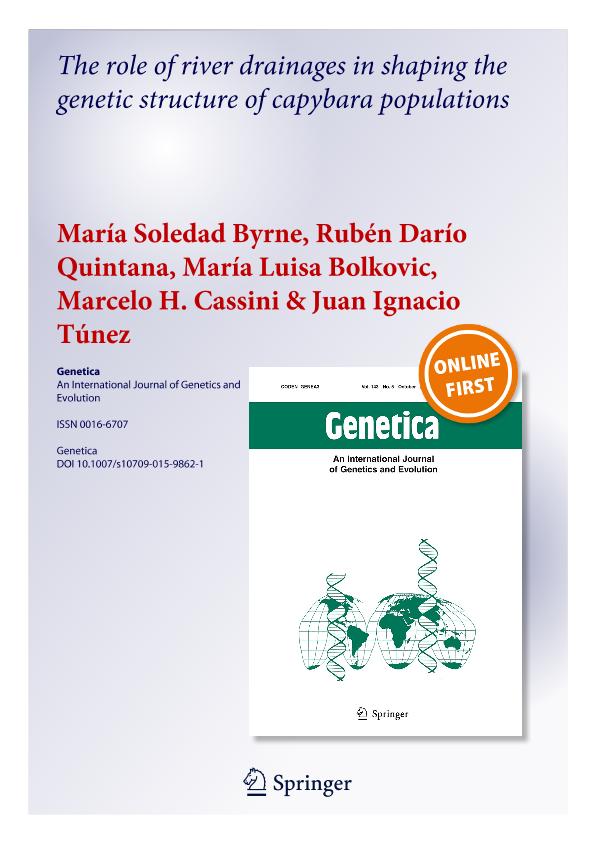Mostrar el registro sencillo del ítem
dc.contributor.author
Byrne, María Soledad

dc.contributor.author
Quintana, Ruben Dario

dc.contributor.author
Bolkovic, María Luisa
dc.contributor.author
Cassini, Marcelo Hernan

dc.contributor.author
Tunez, Juan Ignacio

dc.date.available
2018-04-16T19:01:47Z
dc.date.issued
2015-09
dc.identifier.citation
Byrne, María Soledad; Quintana, Ruben Dario; Bolkovic, María Luisa; Cassini, Marcelo Hernan; Tunez, Juan Ignacio; The role of river drainages in shaping the genetic structure of capybara populations; Springer; Genetica; 143; 6; 9-2015; 645-656
dc.identifier.issn
0016-6707
dc.identifier.uri
http://hdl.handle.net/11336/42174
dc.description.abstract
The capybara, Hydrochoerus hydrochaeris, is an herbivorous rodent widely distributed throughout most of South American wetlands that lives closely associated with aquatic environments. In this work, we studied the genetic structure of the capybara throughout part of its geographic range in Argentina using a DNA fragment of the mitochondrial control region. Haplotypes obtained were compared with those available for populations from Paraguay and Venezuela. We found 22 haplotypes in 303 individuals. Hierarchical AMOVAs were performed to evaluate the role of river drainages in shaping the genetic structure of capybara populations at the regional and basin scales. In addition, two landscape genetic models, isolation by distance and isolation by resistance, were used to test whether genetic distance was associated with Euclidean distance (i.e. isolation by distance) or river corridor distance (i.e. isolation by resistance) at the basin scale. At the regional scale, the results of the AMOVA grouping populations by mayor river basins showed significant differences between them. At the basin scale, we also found significant differences between sub-basins in Paraguay, together with a significant correlation between genetic and river corridor distance. For Argentina and Venezuela, results were not significant. These results suggest that in Paraguay, the current genetic structure of capybaras is associated with the lack of dispersion corridors through permanent rivers. In contrast, limited structuring in Argentina and Venezuela is likely the result of periodic flooding facilitating dispersion.
dc.format
application/pdf
dc.language.iso
eng
dc.publisher
Springer

dc.rights
info:eu-repo/semantics/openAccess
dc.rights.uri
https://creativecommons.org/licenses/by-nc-sa/2.5/ar/
dc.subject
Hydrochoerus Hydrochaeris
dc.subject
Mitochondrial Dna
dc.subject
Hvri
dc.subject
River Basins
dc.subject
South America
dc.subject.classification
Otras Ciencias Biológicas

dc.subject.classification
Ciencias Biológicas

dc.subject.classification
CIENCIAS NATURALES Y EXACTAS

dc.title
The role of river drainages in shaping the genetic structure of capybara populations
dc.type
info:eu-repo/semantics/article
dc.type
info:ar-repo/semantics/artículo
dc.type
info:eu-repo/semantics/publishedVersion
dc.date.updated
2018-04-12T14:29:15Z
dc.identifier.eissn
1573-6857
dc.journal.volume
143
dc.journal.number
6
dc.journal.pagination
645-656
dc.journal.pais
Suiza

dc.description.fil
Fil: Byrne, María Soledad. Universidad Nacional de Luján. Departamento de Ciencias Básicas. Grupo de Estudios en Ecología de Mamíferos; Argentina. Provincia de Buenos Aires. Gobernación. Comisión de Investigaciones Científicas; Argentina. Consejo Nacional de Investigaciones Científicas y Técnicas; Argentina
dc.description.fil
Fil: Quintana, Ruben Dario. Universidad Nacional de San Martín. Instituto de Investigación e Ingeniería Ambiental; Argentina. Universidad de Buenos Aires. Facultad de Ciencias Exactas y Naturales. Departamento de Ecología, Genética y Evolución; Argentina. Consejo Nacional de Investigaciones Científicas y Técnicas; Argentina
dc.description.fil
Fil: Bolkovic, María Luisa. Secretaría de Ambiente y Desarrallo Sustentable de la Nación; Argentina
dc.description.fil
Fil: Cassini, Marcelo Hernan. Universidad Nacional de Luján. Departamento de Ciencias Básicas. Grupo de Estudios en Ecología de Mamíferos; Argentina. Consejo Nacional de Investigaciones Científicas y Técnicas. Instituto de Biología y Medicina Experimental. Fundación de Instituto de Biología y Medicina Experimental. Instituto de Biología y Medicina Experimental; Argentina
dc.description.fil
Fil: Tunez, Juan Ignacio. Universidad Nacional de Luján. Departamento de Ciencias Básicas. Grupo de Estudios en Ecología de Mamíferos; Argentina. Consejo Nacional de Investigaciones Científicas y Técnicas; Argentina
dc.journal.title
Genetica

dc.relation.alternativeid
info:eu-repo/semantics/altIdentifier/doi/http://dx.doi.org/10.1007/s10709-015-9862-1
dc.relation.alternativeid
info:eu-repo/semantics/altIdentifier/url/https://link.springer.com/article/10.1007%2Fs10709-015-9862-1
Archivos asociados
